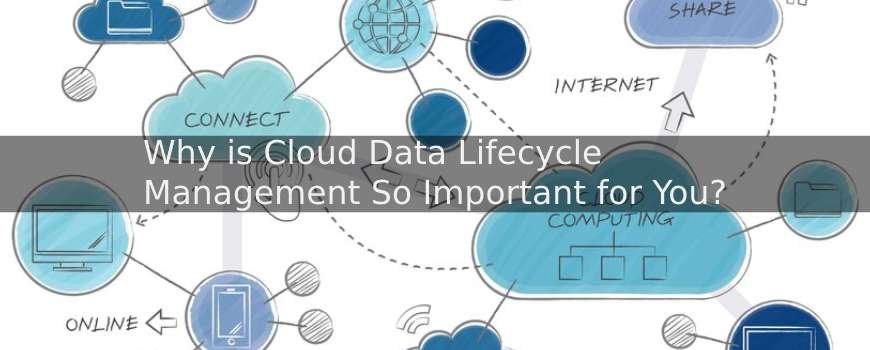Experienced and Reliabile Hosting Service Provider! Switch to Cloudies365 and Save Upto 50% ![]()
Why is Cloud Data Lifecycle Management So Important for You?

In today’s world, we are all aware how competition has increased. We live in such a data driven world that bringing out new business is just quite easy. However, this same can bring in serious competition in business sectors. Not just this, data also brings in some serious challenges that need to addressed.
Data Lifecycle Management (DLM)
If an organization can effectively connect data with a lifecycle, then managing that data will be much easier. Ultimately, the information you produce or obtain has an expiration date, beyond which it becomes less useful.
Thus, you will not only be in a much better position to manage your company data if you can effectively map its whole lifespan, but you will also be in a commanding position to use this data to your fullest advantage.
Suggested Reading: QuickBooks Tool Hub Download, Install to Fix QuickBooks Errors
DLM from a standpoint of security
Enterprises use data that is not only valuable from a commercial standpoint, but also needs to comply with industry-mandated security standards for each class of data it uses. Consequently, security must given top priority when establishing DLM’s specifications.
Taking a security-focused approach to data lifecycle management (DLM) will increase the degree of confidence that your important stakeholders and clients have in you. In light of the ever-increasing data-related regulatory standards, this is especially crucial.
Data Lifecycle by the Cloud Security Alliance (CSA)
Based on its unique needs and regulatory standards, the data lifecycle of each enterprise will vary. However, the Cloud Security Alliance (CSA), has an outlined generic lifecycle for cloud data, which is like a great starting point for various enterprises.
With the help of this article, we will briefly talk about the six stages of the cloud data lifecycle, and how each enterprise can use this blueprint to its fullest advantage.
The six different stages that included in the cloud data lifecycle are:
Create/Procure
Starting from a choice between creation and procurement of data, the first stage could vary. Some enterprises can draw from internal sources for data creation. However, there are also others that tend to procure the same industry experts and extract business insights from it.
Now that you have reached this stage, it is important for you to take into account the security and compliance related credentials of your public Cloud Service Provider (CSP). For Instance: The data centers of Cloudies365 will help you in meeting some of the industry’s best standards for security and privacy.
Store
At this point in the data lifecycle, issues about the ideal storage location for each type of data will arise. It can stored fully in the public cloud or, alternatively, an organization may decide to store part of the data on site and store the remainder in public cloud data centers.
Use
If you can’t use data to extract value for your business, what use is it? Therefore, one of the main differentiators is how well you can use this data. You can experiment with all this data using almost infinite processing power via the public cloud.
Suggested Reading: Which Common Workflow Error can Cause Duplicate Expenses in QuickBooks Online?
The ultimate objective is to enhance currently offered goods and services while simultaneously locating unexplored opportunities. An organization’s ability to leverage its data will be a major factor in deciding whether it leads its industry or merely follows trends.
Share
The public cloud excels in this crucial stage of the data lifecycle, as is evident. Sharing corporate data with staff members and other important stakeholders is simple when done via the cloud. You benefit from data centralization via the cloud, which is a benefit in and of itself.
But one crucial thing to remember in this situation is that the least privileged access strategy works best. Giving employees access to company data via the cloud only when necessary is the basis of this method of cloud data security.
Archive
Possibly one of the most significant—and even contentious—phases of data lifecycle management is this one. This is the time to determine which data classes are still useful as well as which data’s continued retention will cost the company more money than it will gain.
You may now also specify the effective “timelines” for every distinct corporate data class. Following these deadlines will allow you to optimize costs because there fee associated with holding data on-site or in the cloud.
Destroy
The final and most important phase in data lifecycle management is to destroy any data that no longer needed or has no value for the company. Data that is no longer eligible for preservation must destroyed.
Nevertheless, as you will need to adhere to the recommended best practices for data destruction, this is also a crucial step. Any data that not properly deleted may find its way into the wrong hands and more harmful than beneficial.
Conclusion
An excellent place to start is with the Cloud Security Alliance’s (CSA) data lifecycle. Every business must now implement a cloud data lifecycle that best meets its current and future requirements.
For any of your cloud-based data needs, get in touch with Cloudies365. We have the management and security credentials necessary to meet your business requirements.